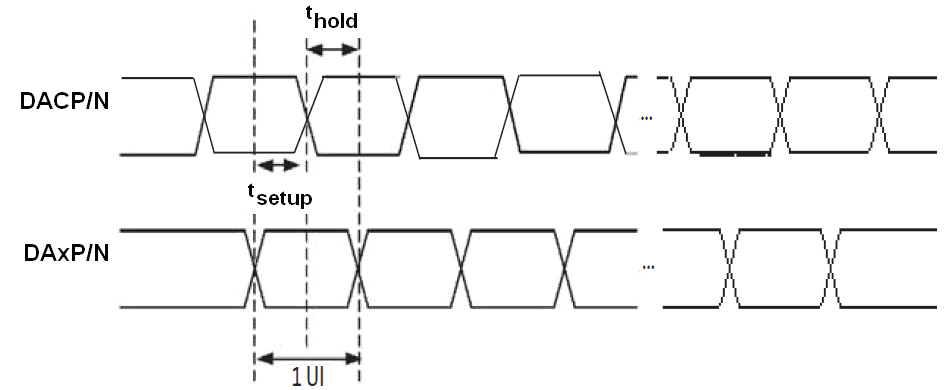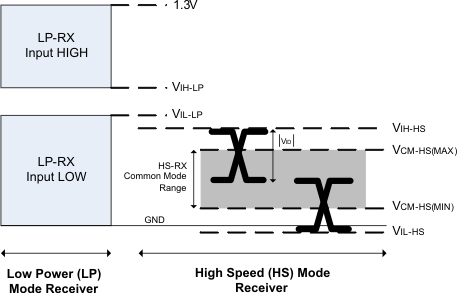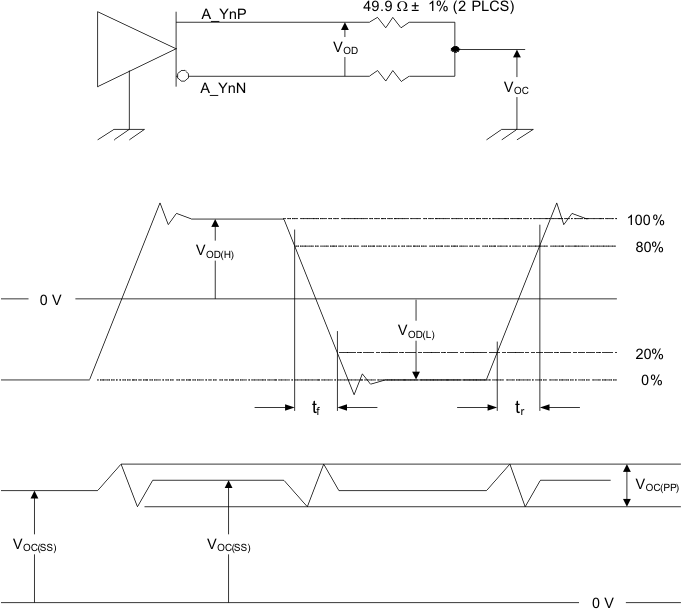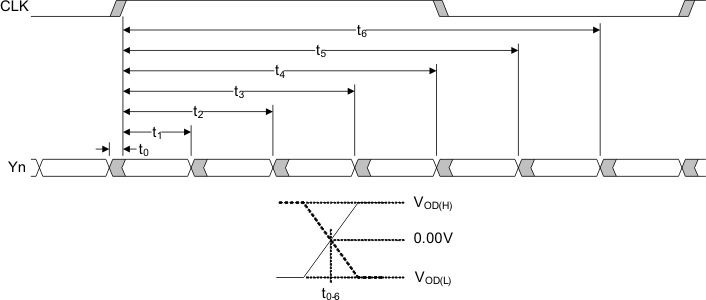ZHCSAT9I september 2012 – october 2020 SN65DSI83
PRODUCTION DATA
- 1
- 1 特性
- 2 应用
- 3 说明
- 4 Revision History
- 5 Pin Configuration and Functions
- 6 Specifications
- 7 Detailed Description
- 8 Application and Implementation
- 9 Power Supply Recommendations
- 10Layout
- 11Device and Documentation Support
- Mechanical, Packaging, and Orderable Information
6.7 Switching Characteristics
over operating free-air temperature range (unless otherwise noted)
| PARAMETER | TEST CONDITIONS | MIN | TYP(1) | MAX | UNIT | |
|---|---|---|---|---|---|---|
| DSI | ||||||
| tGS | DSI LP glitch suppression pulse width | 300 | ps | |||
| LVDS | ||||||
| tc | Output clock period | 6.49 | 40 | ns | ||
| tw | High-level output clock (CLK) pulse duration | 4 / 7 tc | ns | |||
| t0 | Delay time, CLK↑ to 1st serial bit position | tc = 6.49 ns; Input clock jitter < 25 ps (REFCLK) | –0.15 | 0.15 | ns | |
| t1 | Delay time, CLK↑ to 2nd serial bit position | 1 / 7 tc – 0.15 | 1 / 7 tc + 0.15 | ns | ||
| t2 | Delay time, CLK↑ to 3rd serial bit position | 2 / 7 tc – 0.15 | 2 / 7 tc + 0.15 | ns | ||
| t3 | Delay time, CLK↑ to 4th serial bit position | 3 / 7 tc – 0.15 | 3 / 7 tc + 0.15 | ns | ||
| t4 | Delay time, CLK↑ to 5th serial bit position | 4 / 7 tc – 0.15 | 4 / 7 tc + 0.15 | ns | ||
| t5 | Delay time, CLK↑ to 6th serial bit position | 5 / 7 tc – 0.15 | 5 / 7 tc + 0.15 | ns | ||
| t6 | Delay time, CLK↑ to 7th serial bit position | 6 / 7 tc – 0.15 | 6 / 7 tc + 0.15 | ns | ||
| tr | Differential output rise time | See Figure 6-4 | 180 | 500 | ps | |
| tf | Differential output fall time | |||||
| EN, ULPS, RESET | ||||||
| ten | Enable time from EN or ULPS | tc(o) = 12.9 ns | 1 | ms | ||
| tdis | Disable time to standby | 0.1 | ||||
| treset | Reset Time | 10 | ms | |||
| REFCLK | ||||||
| FREFCLK | REFCLK freqeuncy. Supported frequencies: 25 MHz to 154 MHz | 25 | 154 | MHz | ||
| tr, tf | REFCLK rise and fall time | 100 ps | 1 ns | s | ||
| tpj | REFCLK peak-to-peak phase jitter | 50 | ps | |||
| Duty | REFCLK duty cycle | 40% | 50% | 60% | ||
| REFCLK or DSI CLK (DACP/N, DBCP/N) | ||||||
| SSC_CLKIN | SSC enabled input CLK center spread depth (2) | 0.5% | 1% | 2% | ||
| Modulation frequency range | 30 | 60 | kHz | |||
(1) All typical values are at VCC = 1.8 V and TA = 25°C
(2) For EMI reduction purpose, the SN65DSI83 device supports the center spreading of the LVDS CLK output through the REFCLK or DSI CLK input. The center spread CLK input to the REFCLK or DSI CLK is passed through to the LVDS CLK output A_CLKP and A_CLKN, or B_CLKP and B_CLKN, or both.
 Figure 6-1 DSI HS Mode Receiver Timing Definitions
Figure 6-1 DSI HS Mode Receiver Timing Definitions Figure 6-2 DSI Receiver Voltage Definitions
Figure 6-2 DSI Receiver Voltage Definitions Figure 6-3 Test Load and Voltage Definitions for FlatLink Outputs
Figure 6-3 Test Load and Voltage Definitions for FlatLink Outputs Figure 6-4 SN65DSI83 FlatLink Timing Definitions
Figure 6-4 SN65DSI83 FlatLink Timing Definitions
A. See Section 7.3.2 for the ULPS entry and exit sequence.
B. ULPS entry and exit protocol and timing requirements must be met per MIPI DPHY specification.
Figure 6-5 ULPS Timing Definition